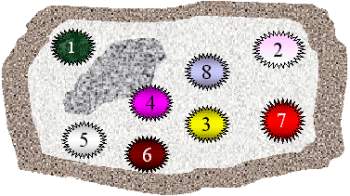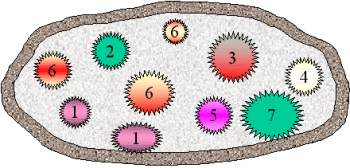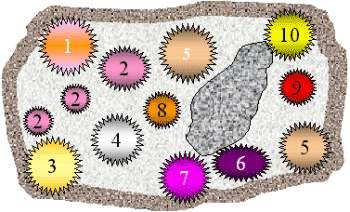This article was originally published on the web on thealpinegarden.com however that website is defunct at May 2015. The copyright is with the original owners of thealpinegarden.com
Planting schemes for Trough Gardens
a joint venture with Duncan McAlpine
Introduction
This guy Duncan McAlpine, who taught me everything I know, decided in his infinite wisdom that I obviously needed more practice... and so, he asked me to come up with a page on planting schemes to complement our respective sites on trough gardening. Never one to resist a challenge (or the work that goes with it), I thought if that will help our visitors (I hate that word... what would you prefer to be called? "Readers", "Viewers", "Guests"?)... then why not? So for your enjoyment, experimentation and comments, there follows a few suggestions for planting out your troughs.
Theme Troughs
A great source of pleasure to me, is to design and plant out "Theme" troughs. There are many hundreds of theme ideas if you use your imagination.What about
- Plants from your favourite country
- Troughs planted with your favourite colours
- Single genus troughs
- Troughs from an AGS/NARGS seedlist selection
- Plants of architectural shape
- Silver leaved planting schemes
- Ericaceous only troughs
- Plants that flower in your birthday week (Well maybe that's going a bit too far)
But you get the idea, don't you?
Let's have a look at some of these:
New Zealand Alpine plants in troughs
There are many beautiful plants from the Antipodes that are suitable for trough culture and a scheme can be designed to enjoy the colour, form and architecture of these plants for many a long-lasting season.
Despite what has often been written about New Zealand flowers being any shade of white, I hope to offer a diverse colour range for your trough, from yellow buttercups and pink koromikos to blue harebells. Many, if not all of the plants that are mentioned can be obtained from the seedlist offered as part of the membership benefits of the NZAGS.
The New Zealand flora has a number of specimen plants to offer for trough lovers. The Helichrysums, coralloides and selago, make compact, yet stately additions to the trough garden and are interesting focal points with their "woolly" whipcord foliage and yellow daisy flowers. Other focal plants include Leucopogon suaveolens (chameleon-like foliage), Carmichaelia monroi (purple pea flowers) and of course the dwarf Coprosmas, so exquisite in their fine berrying forms. (NB: You will need both male and female plants to induce fruiting). For those of you who have no sense of pain, there are the "Spaniards", a most lethal but architecturally handsome genus of plants. The sword-like leaves are unswerving in their ability to pierce you where it hurts the most. Beware of Aciphylla horrida, which as its specific epithet implies is "horrid". One negative encounter with this and you will never garden again. A saving grace with this race of thugs, is that it does provide a number of dwarfer specimens which, although no less fearsome, are small enough to be avoided with some care. Aa. dobsonii, spedenii and congesta are species in this category and well worth their place in a trough but not, I hasten to add, in a place easily accessible to children.
For cushion plants, you can't go far wrong in choosing varieties and species of the NZ offerings. Celmisia argentea, a tight cushion of small spiny rosettes of silver, needle-like leaves and pure white, sessile daisy flowers with a golden boss. A real gem for the trough but will probably need protection from wet winter days. It's larger cousin C.sessiliflora is equally suitable for a trough and is possibly easier to cultivate. Pygmaea (Chionohebe) pulvinaris is another splendid cushion which in England, at least, has adapted to cultivation without protection and forms dark green cushions, covered, if one is fortunate, with tiny white flowers. The Abrotanella and Colobanthus species, whilst not as elegant as the other cushion plants mentioned are, nonetheless, excellent trough plants, the latter having bright green cushions which can light up a trough on the darkest of days.
For crevices, there are some wonderful, although extremely difficult subjects to choose from. Lignocarpa carnosula is a fleshy plant with leaves reminiscent of a stag's antlers in a beautiful shade of grey-blue. The yellow flowers lie beneath the foliage as though waiting to erupt in a blaze of colour, which of course they never do but the anticipation is still there. Stellaria roughii is a real tester but worth any effort to provide it with the conditions it likes and deserves. Scree treatment is about your only chance and so a high crevice in a deep trough is possibly the answer (This would also apply to theLignocarpa). Other plants for a crevice include Wahlenbergia cartalaginea (the fleshy harebell), Swainsona novae-zealandia (with glaucous, pinnate foliage and pink flowers) and Hectorella caespitosa (a fine cushion plant also).
For the flat areas of the trough, there are some excellent turf imitators. Scleranthus uniflorus will form mounds, hummocks, cushions - you name it- with apparent ease. Agrostis muscosa is a bluish cushion forming grass (not many of those about) and some of the mat-forming Raoulias, like subulata andtenuicaulis will also spread nicely but in a reserved manner. One of the advantages of growing New Zealand plants, is that they, like no others, actually enjoy plant association instead of vying for supremacy of the soil and its nutrients. Celmisias and Gentians growing up through Scleranthus uniflorus is not an uncommon site in a trough. This can of course be made to happen by sowing seeds directly into the cushions and mats.
For the edges of the trough and to cascade over the sides, there are some lovely Parahebes, Raoulias and Pimelias with a variety of foliage form and colour to choose from. Some of the better ones are Parahebe linifolia, with dark green shiny foliage and sky-blue flowers, Raoulia grandiflora with unusual (for members of the Asteraceae) stellate flowers and almost saxifraga-like rosettes of silver and Pimelia prostrata with its red stems, grey leaves and creamy-white flowers.
Many plant lovers have a special affinity with a foreign country. Perhaps they have visited there, or maybe they have friends or relatives there, or perhaps it is a special dream to go there one day. If you have such an affinity with a particular country, then why not have a daily reminder of that country's flora by making the effort now, to plant up that "special" trough garden.
Now what about
Troughs planted with your favourite colours?
OK, I know it sounds a bit _ _ _ _ _ _ (you are entitled to enter any word you think adequately describes the topic....but remember, this a a "family friendly" site).
Think about it though. Everyone has their favourite football team...mine just happens to be Manchester City (and it took a lot of courage to admit that). Their colours are sky-blue and white (Campanulas and Celmisias). Or what about that wedding bouquet with yellow and white tea roses. (Ranunculusand Arenaria) or the favourite sweatshirt in purple and cream (Penstemons and Aquilegias)....Yes, I know nobody has a purple and cream sweatshirt but use your imagination.
Follow the drift? Given some thought and preparation, it is possible to plant troughs to give plants of different colour and contrasts throughout the season. I would be very interested in what ideas you come up with.
Now to something marginally more sensible
The Single Genus trough
These can be amongst the most rewarding troughs of all especially if you want to have colour all the year round. There are so many genera to choose from: Saxifrages, Primulas, Sedums, Sempervivums, Lewisias, Arenarias, Campanulas etc., etc.
Saxifraga
There is nothing more satisfying than a trough filled with saxifrages in spring. They are amongst the most accommodating of alpine plants with species that will cascade, over the sides of a trough (S.oppositifolia), mound into superb cushions (Ss.pedemontana, iranica), form tight mats (Ss.georgii,hypostoma, stolitzkae), flower in acidic soils (S.lilacina) and give the most magnificent flowering displays (S. 'Tumbling Waters'). The hybrids too, provide a wealth of colour S.'Penelope' (apricot), S.'Love Me' (salmon pink), S. 'Judith Shackleton '(white) and S. 'Ellie Brinkerhof' (deep maroon). There are so many 'new' saxes coming into cultivation nowadays that the combinations are endless. Whether large or small, your trough can be a mass of colour throughout the spring.
Primula
So much depends on the floriferousness of the clone but there are some excellent trough primulas available through the trade at the moment. Often short lived (unless regularly divided), they provide good colour during the spring. Ones to try are Pp minima, pedemontana, allionii, viscosa, integrifolia, marginata, pubescens and the various hybrids that have been made from these and are now generally available from nurseries
Just a couple of examples there to encourage you to come up with your own ideas. Obviously, you will know which plants perform well for you and these should be your first choice but try those you never thought of...they may well surprise you. The other side of course to planting a SGT is that you may very well be rewarded with a brand new hybrid.
Troughs from a Seedlist collection
Every year, we alpiners study the seedlists and hope that we can obtain that which we have sought for many years, or perhaps that which is relatively new to cultivation or even that which we have grown in the past but sadly lost.
This next time, why not choose plants that are amenable to trough cultivation and sow them directly into a trough. This is not as difficult as it may at first appear. Prepare your trough, complete with landscaping, including crevices etc. and fill it with a compost similar to what you would normally use for your seed sowing. Ensure that the compost has settled well and then just sprinkle on the seed. You will be surprised how well this works. In fact, I have had success with this method where previously, all attempts at germination of certain species had failed. Try it with say, 10% of the seeds you receive and I am sure that you will be pleased with the results.
Suggested planting schemes - the graphics
The following trough schematics have been prepared by Duncan and will give you a base upon which to design and plan your own arrangements.
Trough One

- Juniperus communis compressa
- Dianthus 'Pikes Pink'
- Saxifraga x elisabethae 'Primrose Dame'
- Androsace sempervivoides
- Saxifraga 'Silver Cushion'
- Sempervivum 'Black Prince'
- Phlox subulata 'Temiscaming'
- Anemone blanda
Trough Two

- Juniperus communis compressa
- Gentiana acaulis
- Sisyrinchium californicum
- Saxifraga 'Whitehills'
- Armeria maritima 'Dusseldorfer Stoltz'
- Saxifraga x elisabethae 'Primrose Dame'
- Phlox subulata
- Dianthus 'La Bourbille'
- Phlox subulata
Trough Three

- Dianthus 'Pink Jewel'
- Androsace sarmentosa
- Sedum spathulifolium
- Saxifraga x apiculata
- Erinus alpinus
- Sempervivum arachnoideum
- Sedum 'Dudley Field'
Trough Four

- Saxifraga 'Penelope
- Asperula gussonnii
- Draba hispanica
- Saxifraga hypostoma
- Saxifraga stolitzkae
- Saxifraga x hornibrookii 'Ellie Brinkerhof'
- Saxifraga oppositifolia 'Theoden'
- Saxifraga 'Love Me'
- Saxifraga oppositifolia x biflora
- Saxifraga 'Primrose Bee'
See a list of plants suitable for a Trough Garden